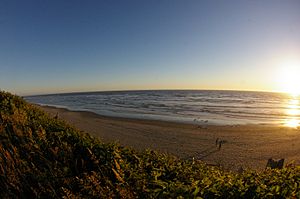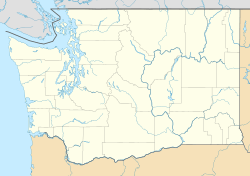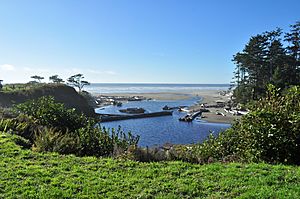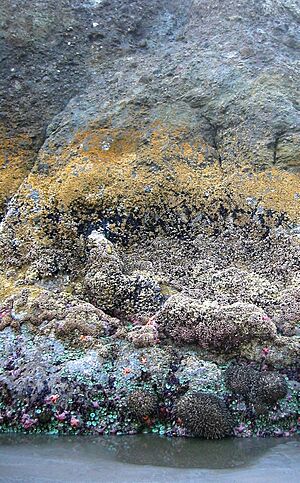Kalaloch, Washington facts for kids
Quick facts for kids
Kalaloch, Washington
|
|
|---|---|

Kalaloch Beach
|
|
| Country | United States |
| State | Washington |
| County | Jefferson |
| Time zone | UTC-8 (Pacific (PST)) |
| • Summer (DST) | UTC-7 (PDT) |
| ZIP code |
98331
|
| Area code(s) | 360 |
Kalaloch is a special resort area located entirely within Olympic National Park in Washington State, USA. It's not a city or town, but a place where people can stay and enjoy nature. Kalaloch offers a lodge, cabins, and campgrounds. These are all built on a bluff, which is a high cliff, about 50 feet (15 meters) above the Pacific Ocean. It's found west of U.S. Route 101 on the Olympic Peninsula.
The name Kalaloch comes from the Quinault language. The original word was k'–E–le–ok. It means "a good place to land" or "a sheltered landing spot for canoes." This area was one of the few safe places for Native American dugout canoes to land between the Quinault River and Hoh River.
Contents
History of Kalaloch and Olympic National Park
People have lived on the Olympic Peninsula for a very long time. Scientists have found old tools and items that show humans were here between 6,000 and 12,000 years ago. Today, eight different Native American tribes live on reservations along the coast. These tribes include the Elwha Klallam, Hoh, Jamestown S'Klallam, Makah, Port Gamble, Quileute, Quinault, S'Klallam, and Skokomish. In the mid-1800s, these tribes agreed to share their lands and waters with the United States government.
In 1889, Washington became a state. Later, in 1897, President Grover Cleveland created the Olympic Forest Reserve to protect the forests. This area was renamed Olympic National Forest in 1907.
A man named Charles W. Becker, Sr., bought some land near Kalaloch Creek in 1925. He used wood from logs that washed up on the beach to build a main lodge and cabins. This was the start of the Kalaloch resort.
To protect more of Washington's beautiful old-growth forests, President Franklin D. Roosevelt created Olympic National Park in 1938. It covered a huge area of about 898,000 acres (3,634 square kilometers). Two years later, he added more land to the park. In 1953, President Harry S. Truman added about 75 miles (121 kilometers) of coastal wilderness to the park, which included the Kalaloch area.
Olympic National Park has received special recognition over the years. In 1976, it was named an International Biosphere Reserve. This means it's a place where nature is protected, and people can learn about it. The National Park Service (NPS) bought the Becker property in 1978 and renamed it Kalaloch Lodge. In 1981, Olympic National Park became a World Heritage Site. This is a place recognized by the world for its special cultural or natural importance. Finally, in 1988, most of the park was designated as the Olympic Wilderness, meaning it's kept wild and untouched.
Kalaloch's Climate and Weather
The weather at Kalaloch is greatly affected by the Pacific Ocean winds. It's also influenced by two nearby temperate rainforests: the Hoh Rainforest and the Quinault Rainforest. A temperate rainforest is a forest that gets a lot of rain but doesn't have extreme temperatures.
Kalaloch receives a lot of rain every year, about 8.5 feet (2.6 meters) on average.
- Spring: About 8.94 inches (227 mm) of rain per month.
- Summer: About 3.13 inches (80 mm) of rain per month.
- Fall: About 11.17 inches (284 mm) of rain per month.
- Winter: About 17.12 inches (435 mm) of rain per month.
Fun Activities at Kalaloch
Olympic National Park has about 73 miles (117 kilometers) of beach, which is perfect for beachcombing. At Kalaloch, there are seven trails that lead down to the beach. These trails are great for coastal hikes and exploring Kalaloch Creek.
If you like fishing, you might catch surf perch, salmon, or native trout. At low tide, you can even dig for razor clams.
Kalaloch is also a fantastic spot for birdwatchers. You might see Bald eagles, black-legged kittiwakes, red-throated loons, black scoters, and brown pelicans. From the bluffs, you can watch for animals in the ocean. Many people enjoy whale watching here, especially for migratory gray whales. You might also spot sea lions, harbor porpoise, harbor seals, sea otters, and even orcas.
During the summer, the National Park Service has a ranger station in the area. Park rangers can answer your questions and help you learn more about Kalaloch.
Kalaloch Lodge and Campground
Kalaloch Lodge offers different places to stay: rooms in the main lodge, separate cabins, and a campground. In the past, there were many cabins, including some with amazing views of the ocean from the bluff.
However, the bluffs at Kalaloch have experienced some erosion. This means the land has slowly worn away due to the ocean and weather. Because of this erosion, seven cabins had to be taken down in 2023 and 2024 to keep visitors safe. The National Park Service has said that the main lodge and the other cabins are still safe.
Kalaloch Campground is a large camping area with 166 campsites. It's one of four campgrounds in Olympic National Park where you can make reservations during the summer.
See also
 In Spanish: Kalaloch (Washington) para niños
In Spanish: Kalaloch (Washington) para niños







